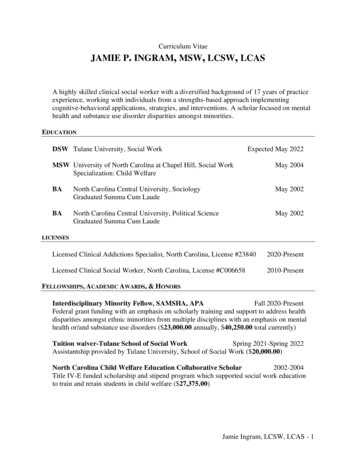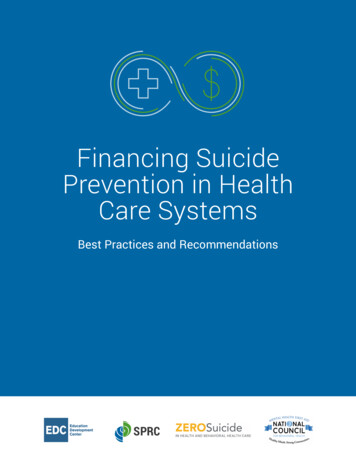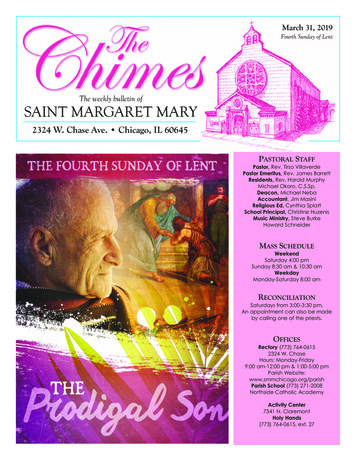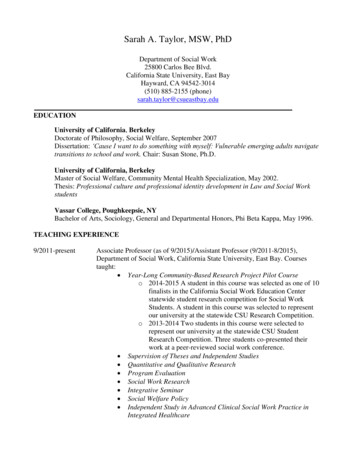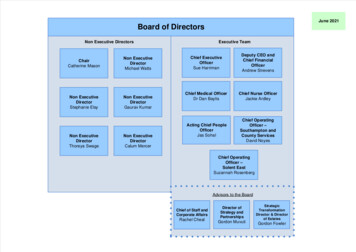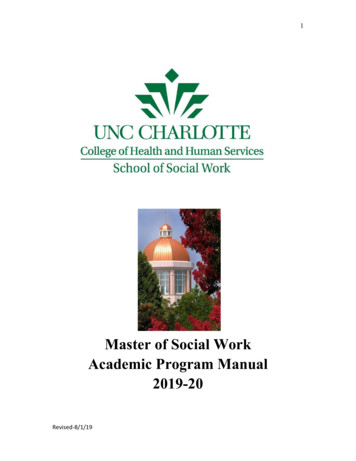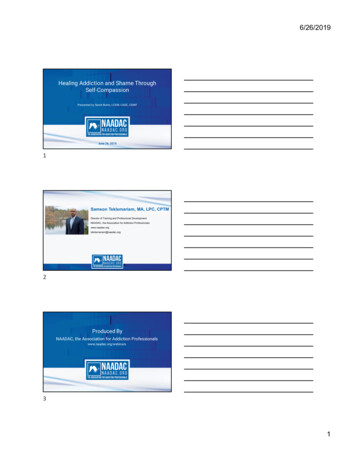
Transcription
6/26/2019Healing Addiction and Shame ThroughSelf-CompassionPresented by Sarah Buino, LCSW, CADC, CDWFJune 26, 20191Samson Teklemariam, MA, LPC, CPTMDirector of Training and Professional DevelopmentNAADAC, the Association for Addiction 2Produced ByNAADAC, the Association for Addiction Professionalswww.naadac.org/webinars31
aling-through-self-compassion-webinar5CE CertificateCost to Watch:FreeCE Hours Available:2 CEsCE Certificate forNAADAC Members:FreeCE Certificate forNon-members: 25To obtain a CE Certificate for the time you spent watching thiswebinar:1.2.Watch and listen to this entire webinar.Pass the online CE quiz, which is posted webinar3.If applicable, submit payment for CE certificate or join NAADAC.4.A CE certificate will be emailed to you within 21 days ofsubmitting the quiz.62
6/26/2019Using GoToWebinar – (Live Participants Only) Control Panel Asking Questions Audio (phone preferred) Polling Questions7Webinar PresenterSarah Buino773.892.1933 x 501sarah@headhearttherapy.com8Webinar Learning Objectives1Participants will be able todifferentially defineconcepts such as shame,guilt, self-compassion andself-esteem and how theserelate to addiction.2Participants willdemonstrate anunderstanding ofcomponents of selfcompassion and how theyaffect the psyche.3Participants will be able toutilize mindfulness and selfcompassion to manipulatepsychic distress throughvisualizations and simplesomatic interventions.93
6/26/2019Agenda Introduce shame - differentiate from guilt, humiliation andembarrassment Describe how shame manifests physically and psychologically andimpacts feelings and behaviors Discuss empathy and self-compassion as antidotes to shame Explore components of self-compassion: self-kindness, commonhumanity, mindfulness Expand on mindfulness concepts that clinicians can utilize withclients Experiential self-compassion exercises to practice with clients1011What’s the importance of walking the walk,not just talking the talk?124
6/26/2019Not-So-Hidden Agenda13Activity Question:How do you define shame in your own words?14How do you see shame? How do you define shame in your own words? List three words that describe shame If shame were what would it be? Color Food Piece of clothing Draw a picture of shame155
6/26/201916Defining ShameDifferentiate shame from guilt, embarrassment, humiliation Shame "I am bad" Guilt "I did something bad" Humiliation – we feel we don't deserve Embarrassment – fleeting, often funny, we know we'renot alone17Polling Question 1:On a scale from 1 to 10, what’s your level of shame on aday to day basis?(1 no shame at all. 10 life-debilitating shame)186
6/26/2019Recognizing Shame in Our ClientsHow do we identify when our clients are in shame?19Recognizing Shame in OurselvesHave you experienced shame whileworking with a client? What did you do/say? How did you know it was shame? Did you do/say anything you regretted?20Origins of ShameShame begins as a two-person experience andbecomes a one-person experience.Shame develops in our first known community our family of origin Overt “You good-for-nothing ” Abuse/neglect Covert Rigid ideology Parental attitudes (family rules) Parent/sibling success217
6/26/2019Shame and AttachmentShame is an ineffective mechanism that a child utilizes asan attempt to preserve attachment–When early attachment isdisrupted (by abuse, neglector a parent’s own attachmentissues) a child will blameoneself, not the parent,resulting in internal messagesof not being good enough22Shame: The Armor We Wear Perfectionism Narcissism Self-Loathing23Shame: The Shields We Use Moving away Moving towards Moving against Flight Fawn Fight248
6/26/201925Empathy1. Staying out ofjudgement2. Perspective-taking3. Recognizingemotion4. Communicating theunderstanding ofthat emotion26Empathy versus Sympathy279
6/26/2019Practicing Shame-Resilience Recognizing shame/triggers Practicing critical awareness Reaching out (for empathy) Reaching in (for self-compassion) Speaking shame (telling our story)2829Self-Compassion3010
6/26/2019Polling Question 2:On a scale of 1 to 10, what is your level ofself-love on a daily basis?31Why Self-Compassion?32What is Self-Compassion? Compassion means “to suffer with” Recognition that you’re experiencing suffering andbeing kind to yourself in that moment Self-compassion is a practice of goodwill, notgood feelings. We’re not trying to make badfeelings go away or pretend they aren’t there. Justholding loving space for ourselves when we do feelnegative emotions3311
6/26/201934What Self-Compassion is Not Self-pity emphasizesegoistic feelings ofseparationVERSUS Self-compassionemphasizes connectionto others throughsuffering35What Self-Compassion is Not Self-indulgence We fear that self-compassion will be lettingourselves off the hook. And if we let ourselvesoff the hook, we’ll never change or we’ll getaway with “bad” behavior.VERSUS Self-compassion People who practice kindness to themselvesactually show MORE capacity for growth andchange.3612
6/26/2019Polling Question 3:Self-Esteem versus Self-WorthCan you name 3 – 5 things that you are good at and feel proud of?37Self-Esteem versus Self-Worth Self-esteem is what we THINK Self-worth is how we FEEL38What Self-Compassion is Not Self-esteem Self-esteem forces comparison to others Requires us to be “better than” in order to feelgoodTwo major issues with attempting to raise our selfesteem1. We’ll never be better than everyone at everything2. In areas where we do excel narcissism or selfabsorption can distance us from others3913
6/26/2019What Self-Compassion is Not Weakness Weakness is: faulty, flawed, defective, deficient Vulnerability is uncertainty, risk and emotionalexposure Self-compassion can enhance our feelings of selfworth by increasing our connection to others40What is Self-Compassion? Self-kindness: when we speak to ourselves as wewould speak to someone we love Common humanity: the understanding that we’re allstruggling, and no one’s pain is worse than another’s Mindfulness: recognizing we’re experiencing emotionrather than being carried away by the emotion41Self-Compassion is a -compassionate-you-are/4214
6/26/2019MindfulnessMindfulness is paying attention to the presentmoment without judgement Mindfulness is the foundation upon which wecan build self-compassion skills Mindfulness skills are improved by meditation What gets in the way of cultivatingyour own meditation practice?43Mindfulness of the Body Observing strong emotions with openness andacceptance increases our capacity to toleratethese emotions and decreases emotionalreactivity. Strong emotions have physical sensations andthoughts associated with them. Goal is to help clients understand how acceptanceleads to less stress and pain.444515
6/26/2019Mindfulness of Emotion46Mindfulness of Thought If we can’t change the content of a thought, we canchange the way we relate to that thought.(Steven Hayes-Acceptance and CommitmentTherapy) Instead of believing in a thought or trying to argueagainst it, we can notice it with curiosity. Emotions are made up of bodily sensations andthoughts/perceptions. Emotions are INFORMATION47Core Organizers of Sensorimotor Psychotherapy4816
6/26/2019Meditation Break49Utilizing Self-Compassion in Psychotherapy Psychic circulation - the ability to simultaneouslycare for ourselves during times of suffering whilecultivating our happiness (Tim Desmond) Must cultivate skills to tolerate suffering!! When we bring attention to suffering: We can embrace it in a way that heals We can be overwhelmed and feel worse(backdraft)505117
6/26/2019Science and Self-Compassion Affective Neuroscience - Jaak Panksepp Basic emotional circuitry shared by all mammals Care Circuit: generates oxytocin and endogenousopioids to create calm and content feeling From a neuroscience perspective - activating theCare Circuit while simultaneously activating adistressing memory actually transforms thatmemory -- through a process called memoryreconsolidation -- so that it becomes lessdistressing52Embracing Suffering with Compassion Step One Turn attention towards suffering Step Two Focus on bodily sensations, NOT THOUGHTS We can’t bring true compassion to our feelingsunless we begin with acceptance of what is Step Three Actively direct compassion towards suffering53Practicing Self-Compassion Bring to mind a recent memory where you experiencedsuffering or pain(Try to make this memory fairly benign for the purposes ofour exercise today. Not a traumatic memory.) Place your hand on your heart, or fold your hands and holdthem in your lap. Think of this moment of pain and suffering, and activelygive yourself love while you do so. You can repeat the phrase “May you be happy, may yoube healthy, may you be safe, may you be loved.” Or you can visualize the pain as a heavy stone and theself-compassion as a white or golden light. And as thelight shines on the stone, imagine the stone shrinks insize and weight.5418
6/26/2019What came up for you?55What gets in the way? “It feels cheesy ” “I’m not worthy of self-compassion.” “I’ll be letting myself off the hook.”“The curious paradox is that when I accept myselfjust as I am, then I can change.”- Carl Rogers56Next Steps in Self-CompassionModularity - the mind is made of different “parts” Notice different parts of self (often a critic and a victim) Acknowledge and give compassion to each part What would you say to the critical part of you? What would you say to the victim part of you? Inner critic is NOT the enemy - attend and befriend ratherthan fight5719
6/26/2019Somatic Experiment Ask client for permission to do a somatic experiment with you Client calls to mind a mild-moderately distressing situation (NOT amajor trauma) Track what’s happening in a client’s body as they recall the story Client tunes into inner experience or movements they make as they tellthe story Is there a particular movement the body wants to make? Or asensation they notice? Assist the client in completing this movement or working with thissensation and ask “Does this feel good in your body?” (If no, howdoes the movement/sensation need to be modified)? After the movement seems complete, ask the client to determine acolor, shape, texture, temperature, etc. Ask “What does this tell you about yourself?” Follow the client’s lead - don’t insert your own agenda!58How often do we encourage selfcompassion for our clients, but neglectour own self-compassion?59Takeaways What was the most meaningfulexperience for you today? What piece of information/toolcan you use on your own or withyour clients next week?6020
6/26/2019I have a d ReadingsTara Brach: Radical AcceptanceBrené Brown: I Thought It Was Just Me, The Gifts of Imperfection, Daring Greatly,Rising Strong, Braving the Wilderness, Dare to LeadPema Chodron: When Things Fall ApartRam Dass: Polishing the MirrorTim Desmond: Self-Compassion in Psychotherapy, Self-Compassion Skills WorkbookKent Fisher & Michelle Rapport: Emotional HarmonyRick Hanson: Just One ThingLaurence Heller: Healing Developmental TraumaJack Kornfield: The Wise HeartPeter Levine: Waking the TigerKristin Neff: Self-Compassion, Mindful Self-Compassion WorkbookPat Ogden: Sensorimotor PsychotherapyMichael A Singer: The Untethered Soul62Suggested Somatic Trainings NARM (Neuro-affective relational model) - Laurence Heller https://narmtraining.com/north-america-trainings/ Sensorimotor Psychotherapy - Pat Ogden https://www.sensorimotorpsychotherapy.org/ Somatic Experiencing - Peter Levine https://traumahealing.org/ Somatic Transformation - Sharon Stanley https://somatictransformation.com/ Som-Ex - Kent Fisher and Michelle Rapport ion6321
6/26/2019Let’s Connect!Sarah Buino773.892.1933 x 501sarah@headhearttherapy.comFacebook: www.facebook.com/WoundedHealrTwitter: @HeadHeart Chi OR @WoundedHealrInstagram: self-compassion-webinar65CE CertificateCost to Watch:FreeCE Hours Available:2 CEsCE Certificate forNAADAC Members:FreeCE Certificate forNon-members: 25To obtain a CE Certificate for the time you spent watching thiswebinar:1.2.Watch and listen to this entire webinar.Pass the online CE quiz, which is posted webinar3.If applicable, submit payment for CE certificate or join NAADAC.4.A CE certificate will be emailed to you within 21 days ofsubmitting the quiz.6622
6/26/2019Upcoming Webinars and EventsJuly 10th, 2019August 21st, 2019Gender Responsive Trauma Informed Care: TheFirst 72 HoursStrength-Based Mind-Body Practice: BuildingInternal Resourcesby Charlene Sears-Tolbert, MA, ABD, CAP, ICD&ACby Alyssa Weiss-Quinter, PhD, LMFTJuly 24th, 2019August 28th, 2019Rise in Recovery: The Science of Addiction andSpirituality of HealingIntersection of Race, Culture, Chronic Disease andChronic Painby Kimberly L. Berlin, LCSW, CSAC, MAC, SAP,CCTPby Sherra White, PhD, LPC, LCAS, CRC, CCS, nars68WEBINAR SERIESINDEPENDENT STUDY COURSESOver 145 CEs of free educationalwebinars are available. Educationcredits are FREE for NAADACmembers.Earn CEs at home and at your ownpace (includes study guide andonline examination).CONFERENCESMAGAZINE ARTICLESNAADAC Annual Conference,September 28 – October 2, 2019Orlando, Floridawww.naadac.org/2019annualconferenceIn each issue of Advances inAddiction & Recovery, NAADAC'smagazine, one article is eligible forCEs.CERTIFICATE PROGRAMSFACE-TO-FACE SEMINARSNAADAC offers face-to-faceseminars of varying lengths in theU.S. and abroad.www.naadac.org/educationDemonstrate advanced education in diversetopics with the NAADAC Certificate Programs: Recovery to Practice Conflict Resolution in Recovery National Certificate in Tobacco TreatmentPractice6923
6/26/2019Thank you for joining!NAADACorgNAADAC44 Canal Center Plaza, Suite 301Alexandria, VA 22314phone: 703.741.7686 / 800.548.0497fax: 703.741.7698 / AADAC7024
6/26/2019 3 Using GoToWebinar -(Live Participants Only) Control Panel Asking Questions Audio (phone preferred) Polling Questions Sarah Buino 773.892.1933 x 501
